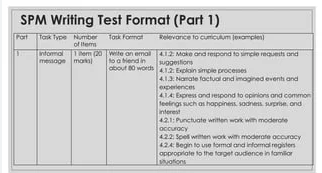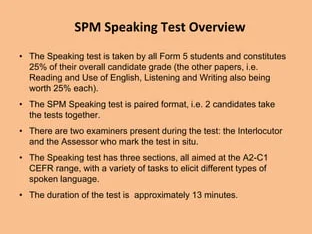The 2024 SPM format introduces technology integration, updated syllabi, enhanced application skills, varied coursework, and revised exam structures.
Table of Contents
Increased Emphasis on Application Skills
-
Summary
-
New format in the 2024 examination process
Register to Free Apply Scholarship ,WhatsApp: +86 15066822096
The 2024 examination format for the Singapore-Cambridge GCE O-Level has a new format, which involves evaluation of students’ performance in applying their knowledge. This upgrading ensures that students are adequately prepared to handle situations in the real world and bridges the gap that exists between theory learning and practical application. Schools have adjusted their curricula to accommodate this change by emphasizing project based-learning and exposure to solving real world problems.
-
A good example of school application of the application skill in the preparation of students
In an application example from the school where the author is taking the attachment, the application is in physics. In this strategy, students are given projects that enable them to learn by developing something real to solve practical problems. The simple circuits they use are a good learning tool in the application of electricity and electronics, where they build simple circuits with the understanding that the materials that are highly conducting improve the efficiency of the circuit. The students measure and then estimate in percentages. The project goal for application in the demonstration of skills is to find out the material that makes the best conducting circuit.
-
Activities in other subjects with application skills of the examination requirements
The mathematics project involves the application of mathematics skills in solving a practical problem in computer programming while the lesson in application is budgeting. In this, students are given tasked to organize for small parties. They have to budget for the party to ensure they do not spend more than they actually have. For geography, the topic in application is urbanization. In this project, the students study the dynamics of urbanization and apply the knowledge about the uses of land and demographics in managing the situation.

Integration of Technology in Assessments
The format of the 2024 SPM examination introduces an even tighter integration of technology to keep up with the changing digital environment and help people acquire the skills they will need for modern work. This change encourages schools to use digital tools in their classes, improving the educational process, and matching the technological demands of higher education and workforce.
In Mathematics, for instance, students use their advanced graphing calculators or software to solve a certain type of problem. That way, they can see certain mathematical concepts and problems, although it compare to using a piece of paper and quick tables. Using this digital technique could help a student solve a problem that took around 30 seconds in a traditional setting in 3 seconds or less. Therefore, in contemporary teaching, technology, speed, and precision are of the utmost importance.
Scientific subjects like Biology and Chemistry benefit greatly from this integration of technology. In these instances, students employ interactive simulations, most of which simply replicate the dynamics of a real biological or chemical process . The experiment might be done with no costs, which apply to real-life equipment and materials, and without high levels of safety that must be observed. Students engage in a titration experiment in a virtual lab scenario, for instance. In that context, even the low-cost setup is becoming too irrelevant to discuss; real-life materials and equipment are too expensive while setting up the lab system costs hundreds.
As for languages and humanities, new types of assessment emerged. For instance, the student engages in an interactive oral examination, possessing a recorded voice speaking to an AI-driven language program. The latter evaluates the student’s fluency, pronunciation, and language use. It is a less superficial method to use for the initial evaluation, and it delivers instant results.
Finally, the backbone of this educational process is the continuous teacher training. When the technology is integrated in such a manner, it is no longer possible for a student to leave the classroom without the necessary digital literacy prowess, let alone missing the chance entirely.
Changes in Subject Content and Syllabus
The 2024 SPM examination format introduces changes in subject content and syllabus that would be more aligned with the current educational standards and the changing needs of industries. Thus, based on the changes, the studies aim to provide students with the requisite knowledge and skills that would govern their successful academic and career pursuits in the future.
Mathematics:
In Mathematics, the area of emphasis that comes with the changes is data analysis. This depicts the role of data and its application within various disciplines such as business. In this area, students are required to interpret data, calculate measures of central tendency. The students also explore the area of data and probability. As a critical skill of professionals in the current industry needs, several industries such as finance, healthcare, and marketing are in need of professionals with data analyst skills.
Science:
The changes are focused on ensuring that the science subjects are aligned to the recent and the new discoveries. For example, in Biology, there can be lessons on new technologies such as CRISPER-Cas9 and their application within medicine and the agricultural industries. Such new discoveries would mean that students are preparing for changes and careers in those fields. Additionally, such changes allow students to understand the recent applications of the technologies concerning their future careers.
Humanities:
In humanities such as History and Geography, the new changes provide a global view of the syllabus. In this context of the changes, long before there was the study of history and geography subjects from a western perspective, focusing just on the western events and processes. However, the new changes aim to also provide the diverse way of transforming studies into a more global perspective.
Languages:
The changes in Languages such as the study of English offer concentration in data and inclusion of current and existing digital and online support materials. In this context, other than reading poems and books written in the early years, students are supported to be able to study modern poems and fiction literature. This prepares them to be able to communicate and adapt to any environment.

Coursework Component
For the 2024 SPM examination format, coursework is used in a much more comprehensive way. As such, it provides a more extensive evaluation of student skills through practical and continuous assessment. Specifically, the change has been introduced because the current student assessment approach often fails to assess their skills in providing a theoretical rather than practical assessment of learners. Overall, new coursework allows students to apply both their theoretical and practical knowledge over time.
In Science:
Since science coursework includes both Chemistry and Physics classes, laboratory experiments are the most widespread method of student assessment. As part of Chemistry, the experiments could range from the measurement of the reaction rates in a solution with different concentrations of the reactants to the speed of the emergence of a particular gas. For Physics experiments, it applies to the laws studied in classes, with students assessing the speed, length, and acceleration of an object in motion to assess their professionalism better.
In Technology and Arts:
In the Design and Technology and Visual Arts classes, students are required to complete an extended project over the course of the semester. The latter aims to ensure a better understanding of the principles of product design selection, with the final outcome usually being a small mechanical device. Therefore, students must conduct research to identify and justify the specifics of design, select the appropriate materials, and assemble the project. As for assessment, the coursework usually includes the drafting of design specifications and a final project assembly. Overall, the latter also provides important skills for possible careers in the mechanical engineering field.
In Humanities:
Although Humanities include Geography and History classes, prolonged long-term coursework demands usually require the latter to research a specific topic for several months. Thus, students can highlight one of their interests, make a proposal and go in-depth to cover the issues identified through the use of a variety of sources. For the final output, students have to prepare their analytical thought by presenting a report. For example, Geography classes may include such assessments as the impact of local urban development on the local ecosystem. It also outputs the use of satellite photos to check the veracity and field data to be on the safe side.
Language:
For the language assessment, it typically includes a student-built portfolio of essays, creative writing, and oral language assessments. Overall, the approach allows teachers to assess the student`s progress, with the output available for students to better understand who they are and what should be improved.
Modified Examination Timing and Structure
The 2024 SPM examination features significant changes in its timing and shipment, aiming to better assess the students’ proficiency and adapt to the shifting demands of modern education. The schedule and the modes of the examination can help alleviate the intense pressure typically associated with the traditional format, resulting in a more supportive environment better suited to revealing the actual level of academic proficiency of a student.
Increased exam period
First of all, the duration of the exam in some subjects that were traditionally held in two hours is now two and a half hours long. The increased duration can provide additional thinking and response time, which is crucial for fields related to mathematics and natural studies. In these subjects, students have to analyze complex problems and provide solutions, which would require time to elaborate on and contemplate. It is important that the additional duration would enable the student not to rush and go through their answers one more time before submission, potentially increasing their performance.
Holding a single test in two sessions
Secondly, some of the exams, such as the test of essay-based questions in History or English Literature, which are typically three-hour tests, are now split into two separate sessions lasting 1.5 hours each. As a result, the students’ eagerness to perform well will be better preserved, as the first part of the test will not result in a fatigue shock, which can still affect the second part of the test as well. as a result of which the result may be inadequate. It means that students will be refreshed and ready to perform to the best of their abilities in the second part of the exam.
Increased use of oral and practical
Finally, the changes include the increase in the proportion of oral and practical tests, primarily found in language and science application subjects. For example, some languages tests now include more frequent and rigorous oral testing in which candidates are either asked to engage in conversation with other participants or to ask for projects.

